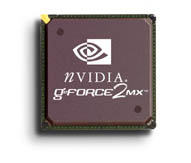Overclocking
 As
with many budget GeForce2 MX cards, the VisionTek card does not come with a
heatsink or fan, leaving the GPU exposed for all to see. Although the chip does
get a bit hot when running at stock speed, heat is obviously not a problem as
the NVIDIA reference design does not call for a heatsink either. Heat does start
to become an issue, however, when the naked GPU is put through the stress of
overclocking.
As
with many budget GeForce2 MX cards, the VisionTek card does not come with a
heatsink or fan, leaving the GPU exposed for all to see. Although the chip does
get a bit hot when running at stock speed, heat is obviously not a problem as
the NVIDIA reference design does not call for a heatsink either. Heat does start
to become an issue, however, when the naked GPU is put through the stress of
overclocking.
Like we found in our Overclocking the GeForce2 MX guide, pushing the MX's core up from the stock 175 MHz does produce a significant amount of heat. In the guide, we were able to squeeze 220 MHz out of the MX by using an active cooling solution. We did not test the VisionTek card in the same manner, as the card ships without any heatsink or fan. We were pleasantly surprised, however, to find that our card had no problem reaching a core speed of 200 MHz with out any passive or active cooling solution. Most likely a product of a good core, being able to reach an overclocked speed of 25 MHz above stock did prove that the VisionTek is a well made card that supplies a good source of power to the GPU.
Although hitting a 200 MHz core speed was nice, almost all the power to be gained from the GeForce2 MX is to be achieved by overclocking the memory bus, as our Overclocking the GeForce2 MX guide proved. Since the GPU on the MX is extremely powerful, the card is very much crippled by the slow SDR memory bus. The way to obtain the maximum performance amount from the GeForce2 MX is to overclock its memory bus, an action that may be a problem with the 7ns memory found on the card.
We were a bit surprised when our test sample hit a memory clock speed of 200 MHz when overclocked. Not only is this 33 MHz over the GeForce2 MX's speced speed, it is 57 MHz over the RAM's rated speed. In comparison, our GeForce2 MX test sample shipped with 6ns memory and was able to reach a max memory speed of 210 MHz, only 10 MHz higher than we were able to push our 7ns part. It is quite possible that VisionTek chose Samsung RAM as their memory supplier and went with slower memory speeds because of a good yields that Samsung may been having with 7ns parts. It is just as likely, unfortunately, that we just got lucky and received a good yield of memory on our card that allowed for such a high overclock. It is for this reason, that our good overclocking success may be simply a fluke, that we remain cautious of any GeForce2 MX card that ships with 7ns memory.
The Drivers
The VisionTek card that we received came with neither drivers nor a manual, showing how truly budget the card is. Neither of these should be cause for concern, however, as a simple installation guide can be found and printed out ahead of time from VisionTek's web site and drivers can be downloaded and made ready for install simply by going to NVIDIA's homepage or by downloading the drivers from VisionTek's web page.
Since the VisionTek GeForce2 MX relies on pure reference drivers, we suggest you take a look at our Detonator3 review to see screen shots as well as detailed information on the newest NVIDIA drivers.










0 Comments
View All Comments